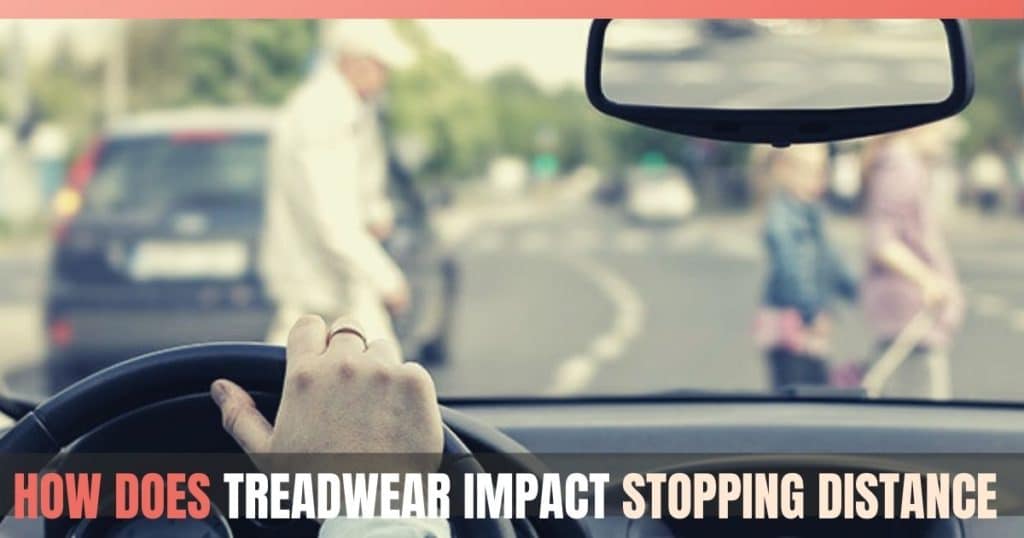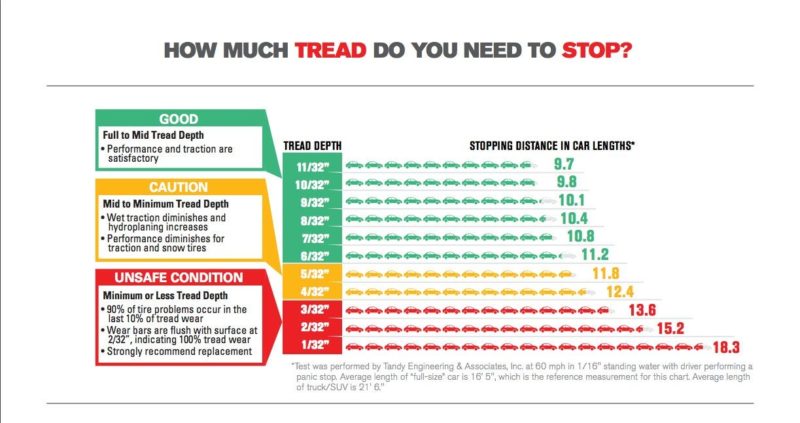
Most people have heard of bald tires and know that it’s not safe to drive on them. Even still, people have a bad habit of neglecting their tires until it’s too late. Understanding a bit about tread depth and how it impacts wet conditions and stopping distance is important as a driver. Below we will discuss the basics of what you need to be better informed driver.
What is Tread Depth?
The depth of a vehicle tire is measured from the top of the tread rubber to the bottom of the deepest tread groove. This is normally measured in inches. You can carry out a visual check of your tires or use a tire tread depth measuring tool that you can buy at local hardware stores.
For reference:
According to Continental Tire, A new passenger car tire has an avg tread depth of 10/32 to 11/32 inches. As you drive the tread depth begins to decrease as the tire wears. When the tread depth reaches 2/32 inches) it is considered bald. The lower the depth of the tread the less traction you have, the less vehicle control you have while braking, and the longer your braking distances are.
When was the last time you checked the tread depth of your tires? If it wasn’t recently, there’s a chance they have worn thin. This can impact your vehicles ability to get traction and help you stop the vehicle when you need it most. Needless to say, an unpredictable stopping distance can be dangerous, one reason tires need to have a legal depth.
Treadwear and Stopping Distance
Tires are specially designed; they have thick rubber treads in various patterns optimized to perform best on dry or wet surfaces. Tires are also made for specific vehicles; some tires are made for speed, while others are made for off-road handling. Either way, quality tires are vital.
Over time, the rubber treads on tires wear down due to friction on the road and constant braking. Tires are central to the vehicle’s braking distance because they maintain a grip on the road and influence traction. This influences braking distance when the brake is triggered.
The more worn the tread, the less traction you have, and the longer your braking distance needs to be.
The Effect of Shallow Treads on Stopping Distance…
Shallow tires are ones where the tread has been worn down over time. This inevitably happens, but it can catch some people by surprise, especially if they are not in the habit of checking their tires regularly.
Shallow tires affect performance, handling, braking distance, and overall safety. While a bald tire is considered 2/32 of an inch of tread, it’s not just a bald tire that struggles with traction, it happens it every increment the tire wears down. Shallow tires also affect the vehicle’s performance and stopping distance, especially when the road surface is icy or wet.
Another impact of low tread depth is a higher chance they will lose air pressure or get punctured. Shallow tires are more likely to cause a blowout.
Driving on Wet Surfaces
One of the reasons tires have grooves is to provide grip on different surface types. The other reason is to provide channels for water to run through. The tire is designed to displace water as it moves along the road, so the surface of the tire maintains better contact with the road.
Naturally, this technology isn’t effective when the tire is worn. When there is less grip, there is less chance of water displacement. Additionally, the tire’s surface is smoother, so that contact with the road is more hazardous. This results in longer braking distances and hydroplaning.
Different Tread Depths
TIres have different tread depths depending on their intended use. Performance tires, for instance, tend to be thinner and have less tread to increase speed; conversely, 4×4 vehicles are designed to handle off-road conditions and tend to have thicker tires with more tread depth.
However, performance is not the only reason for different tread depths. Often, people change their tires in the summer and winter so their vehicles can handle the seasonal conditions. Usually, winter tires have more substantial tread depths and better grips to handle snow and ice. In fact those tires also have directional treads, which help shed water away and improve stopping distance in wet conditions.
Recommendations
Normally, the tires on your vehicle are designed with the vehicle’s main purpose in mind. A saloon vehicle, for instance, will have all-season tires, and their quality will depend on the brand of vehicle. Sports cars tend to have performance tires, and off-road vehicles have terrain tires.
If you don’t know what type of tire you have on your vehicle, it’s time to check .Worn-out tires are not only against the law; they pose a severe safety risk to you and other drivers. Remember, when you change tires, you can buy budget ones, part-worn ones, or ones at full price, depending on requirements and your budget.
When to Change your Tires
Tires need to be changed when the tread is worn down. To check the tread, carry out a visual examination. Some manufacurers have a tread wear indicator notch in between the tire grips that tells you how much of the tire is legally left. You might also use a tire tread measuring gauge which is a little more accurate.
If you only have a bit of tread left, it’s time to change your tire or rotate it with your spare (if you have a full size spare). However, a low grip is not the only reason to change tires. If your tire is 6 years old or older, the rubber wears which can increase the chances of a blowout, so it’s time for a tire change.
Treadwear and Stopping Distance – Conclusion
The amount of treadwear and the stopping distance you need are directly correlated. Understanding how much grip your tires have will help you to become a safer driver. If you know your tires are older, you can keep that in mind as you ease on the brakes perhaps a bit more early then you would have otherwise.
